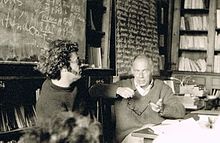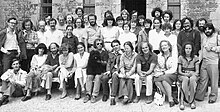Claude Simon
Claude Simon | |
|---|---|
 Simon in 1967 | |
| Born | 10 October 1913 Antananarivo,French Madagascar |
| Died | 6 July 2005(aged 91) Paris,France |
| Occupation | Novelist |
| Nationality | French |
| Notable awards | Nobel Prize in Literature 1985 |
| Spouse | Rea Simon (died 2017) |
Claude Simon(French:[klodsimɔ̃];10 October 1913 – 6 July 2005) was a French novelist and was awarded the1985 Nobel Prize in Literature.
Biography[edit]
Claude Simon was born inTananariveon the isle ofMadagascar.His parents were French, and his father was a career officer who was killed in the First World War. He grew up with his mother and her family inPerpignanin the middle of the wine district ofRoussillon.Among his ancestors was a general from the time of the French Revolution.
After secondary school atCollège Stanislasin Paris and brief sojourns at Oxford and Cambridge, he took courses in painting at theAndré Lhote Academy.He then travelled extensively through Spain, Germany, the Soviet Union, Italy and Greece. This experience as well as those from the Second World War show up in his literary work. At the beginning of the war, Claude Simon took part in the battle of theMeuse(1940) and was taken prisoner. He managed to escape and joined theresistance movement.At the same time, he completed his first novel,Le Tricheur( "The Cheat", published in 1946), which he had started to write before the war.
He lived in Paris and used to spend part of the year atSalsesin the Pyrenees.
In 1960, he was a signatory to theManifesto of the 121in favour of Algerian independence. In 1961 Claude Simon received the prize ofL'ExpressforLa Route des Flandresand in 1967 the Médicis prize forHistoire.TheUniversity of East Angliamade him an honorary doctor in 1973.
Novels[edit]
Much of Claude Simon's writing is autobiographical, dealing with personal experiences fromWorld War IIand theSpanish Civil War,and his family history. His early novels are largely traditional in form, but withLe vent(1957) andL'Herbe(1958) he developed a style associated with theNouveau roman.La Route de Flandres(1960), which tells about wartime experiences, earned him theL'Expressprize and international recognition. InTriptyque(1973) three different stories are mixed together without paragraph breaks. The novelsHistoire(1967),Les Géorgiques(1981) andL'Acacia(1989) are largely about Simon's family history.[1]
Style and influences[edit]
Simon is often identified with thenouveau romanmovement exemplified in the works ofAlain Robbe-GrilletandMichel Butor,and while his fragmented narratives certainly contain some of the formal disruption characteristic of that movement (in particularHistoire,1967, andTriptyque,1973), he nevertheless retains a strong sense of narrative and character.[2]
In fact, Simon arguably has much more in common with his Modernist predecessors than with his contemporaries; in particular, the works ofMarcel ProustandWilliam Faulknerare a clear influence. Simon's use of self-consciously long sentences (often stretching across many pages and with parentheses sometimes interrupting a clause which is only completed pages later) can be seen to reference Proust's style, and Simon moreover makes use of certain Proustian settings (inLa Route des Flandres,for example, the narrator's captain de Reixach is shot by a sniper concealed behind a hawthorn hedge orhaie d'aubépines,a reference to the meeting between Gilberte and the narrator across a hawthorn hedge in Proust'sÀ la recherche du temps perdu).
The Faulknerian influence is evident in the novels' extensive use of a fractured timeline with frequent and potentially disorienting analepsis (moments of chronological discontinuity), and of an extreme form offree indirect speechin which narrative voices (often unidentified) andstreams of consciousnessbleed into the words of the narration. The ghost of Faulkner looms particularly large in 1989'sL'Acacia,which uses a number of non-sequential calendar dates covering a wide chronological period in lieu of chapter headings, a device borrowed from Faulkner'sThe Sound and the Fury.
Themes[edit]
Despite these influences, Simon's work is thematically and stylistically highly original. War is a constant and central theme (indeed it is present in one form or another in almost all of Simon's published works), and Simon often contrasts various individuals' experiences of different historical conflicts in a single novel; World War I and the Second World War inL'Acacia(which also takes into account the impact of war on the widows of soldiers), theFrench Revolutionary Warsand the Second World War inLes Géorgiques.
In addition, many of the novels deal with the notion of family history, those myths and legends which are passed down through generations and which conspire in Simon's work to affect the protagonists' lives. In this regard, the novels make use of a number of leitmotifs which recur in different combinations between novels (a technique also employed byMarguerite Duras), in particular, the suicide of an eighteenth-century ancestor and the death of a contemporary relative by sniper-fire. Finally, almost all of Simon's novels feature horses; Simon was himself an accomplished equestrian and fought in a mounted regiment during World War II (the ridiculousness of mounted soldiers fighting in a mechanised war is a major theme ofLa Route des FlandresandLes Géorgiques).
Simon's principal obsession, however, is with the ways in which humans experience time (another Modernist fascination). The novels often dwell on images of old age, such as the decaying 'LSM' or the old woman (that 'flaccid and ectoplasmic Cassandra') inLes Géorgiques,which are frequently seen through the uncomprehending eyes of childhood. Simon's use of family history equally attempts to show how individuals existin history—that is, how they might feel implicated in the lives and stories of their ancestors who died long ago.
Seminars[edit]


Jean Ricardou(Director):
- Nouveau roman: hier, aujourd'hui,Cerisy (France), 1971.[3]
- Claude Simon: analyse, théorie,Cerisy (France), 1974.[4]
- Pour une théorie matérialiste du texte,Cerisy (France), 1980.[5]
Criticism[edit]
EssayistChristopher Hitchenscriticised Simon's deconstruction ofGeorge Orwell's account of theSpanish Civil War,claiming that Simon had himself fought "on the side of the Stalintern forces." In a further reference to the literary honours bestowed on Simon, Hitchens added: "the award of the Nobel Prize to such a shady literary enterprise is a minor scandal, reflecting the intellectual rot which had been spread by pseudo intellectuals."[6]
Works[edit]
- Le Tricheur(The Cheat) 1946
- La Corde Raide(The Tightrope) 1947
- Gulliver1952
- Le Sacre du printemps(The Rite of Spring) 1954
- Le vent: Tentative de restitution d 'un rétable baroque(The Wind: Attempted Restoration of a Baroque Altarpiece) 1957
- L'Herbe(The Grass) 1958
- La Route des Flandres(The Flanders Road) 1960
- Le Palace(The Palace) 1962
- La Separation(The Separation) 1963; play, adapted from the novelL'Herbe
- Femmes, sur 23 peintures de Joan Miró(Women, on 23 paintings by Joan Miró) 1966; new edition,La Chevelure de Bérénice(Berenice's Hair) 1984
- Histoire(Story) 1967
- La Bataille de Pharsale(The Battle of Pharsalus) 1969
- Orion aveugle: Essai(Blind Orion: Essay) 1970
- Les Corps conducteurs(Conducting Bodies) 1971
- Triptyque(Triptych) 1973
- Leçon de choses(Lesson in Things) 1975
- Les Géorgiques(The Georgics) 1981
- L'Invitation(The Invitation) 1987
- L'Acacia(The Acacia) 1989
- Le jardin des plantes(The Garden of Plants) 1997
- Le tramway(The Trolley) 2001
Collected edition[edit]
Œuvres(Bibliothèque de la Pléiade):
- Tome I (Gallimard, 2006), includingLe Vent: Tentative de restitution d'un retable baroque,La Route des Flandres,Le Palace,La Bataille de Pharsale,La Chevelure de Bérénice(Reprise du texte Femmes),Triptyque,Le Jardin des Plantes,and other writings.
- Tome II (Gallimard, 2013), includingL'Herbe,Histoire,Les Corps conducteurs,Leçon de choses,Les Géorgiques,L'Invitation,L'Acacia,Le Tramway,and other writings.
References[edit]
- ^"Claude Simon".authorscalendar.info.Retrieved4 February2024.
- ^Entre tradition et modernité (1967–1980).ccic-cerisy.asso.fr
- ^"Cerisy, le Centre Culturel International".ccic-cerisy.asso.fr.Retrieved4 February2024.
- ^"CERISY, les colloques (1952 - 2021)".ccic-cerisy.asso.fr.Retrieved4 February2024.
- ^"CERISY, les colloques (1952 - 2021)".ccic-cerisy.asso.fr.Retrieved4 February2024.
- ^Orwell's Victory.Penguin, 2003,ISBN0-465-03050-5,p. 144.
Further reading[edit]
- Brigitte Ferrato-Combe,Ecrire en peintre: Claude Simon et la peinture,ELLUG, Grenoble 1998
- Bernard Luscans,La représentation dans le nouveau nouveau roman,Chapel Hill, Université de Caroline du Nord, 2008.[1]
- Mireille Calle-Gruber,Claude Simon, une vie à écrire,Paris, Ed. du Seuil, 2011.
- Karen L. Gould,Claude Simon's Mythic Muse,French Literature Publications, 1979.ISBN978-99967-795-6-5
- Karen L. Gould and R. Birn (Editors),Orion Blinded: Essays on Claude Simon,Bucknell University Press, 1981.
- Ilias Yocaris,L’impossible totalité. Une étude de la complexité dans l’œuvre de Claude Simon,http://revel.unice.fr/loxias/index.html?id=107,Toronto, Paratexte, 2002.
- Ilias Yocaris: « Vers un nouveau langage romanesque: le collage citationnel dans La Bataille de Pharsale de Claude Simon »,Revue Romane,43, 2, 2008, p. 303–327.
- Ilias Yocaris & David Zemmour: « Qu’est-ce qu’une fiction cubiste? La "construction textuelle du point de vue" dansL’HerbeetLa Route des Flandres»,Semiotica,195, 2013, p. 1-44,https:// linguistiquefrancaise.org/articles/cmlf/pdf/2010/01/cmlf2010_000086.pdf
External links[edit]
- About Claude Simon
- Association des Lecteurs de Claude Simon (ALCS) website for readers of Claude Simon (articles in french and in english)
- Claude Simonon Nobelprize.org
- Petri Liukkonen."Claude Simon".Books and Writers.
- Alexandra Eyle (Spring 1992)."Claude Simon, The Art of Fiction No. 128".The Paris Review.Spring 1992 (122).
- 1913 births
- 2005 deaths
- Burials at Montmartre Cemetery
- French Nobel laureates
- Nobel laureates in Literature
- People from Antananarivo
- Prix Médicis winners
- French Resistance members
- Collège Stanislas de Paris alumni
- Lycée Saint-Louis alumni
- French male novelists
- 20th-century French novelists
- French expatriates in Madagascar
